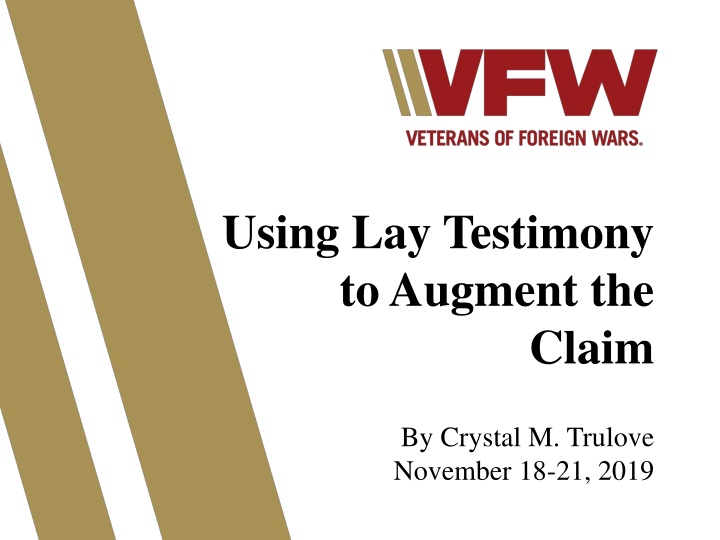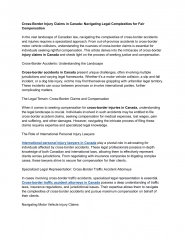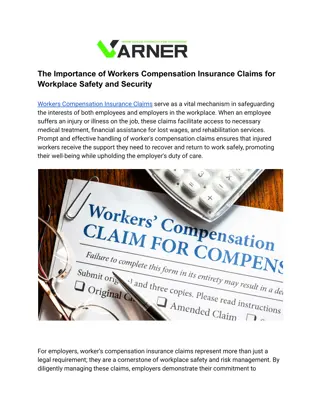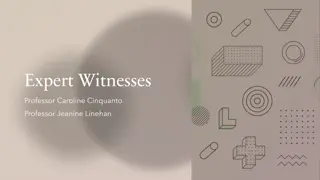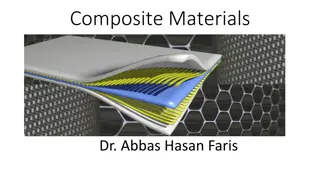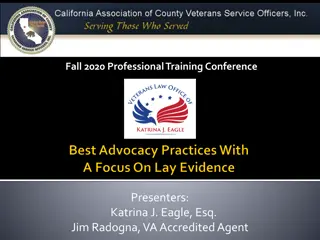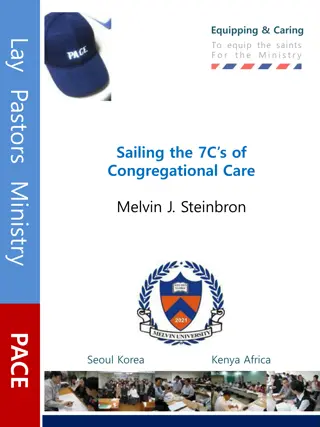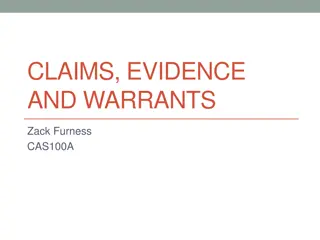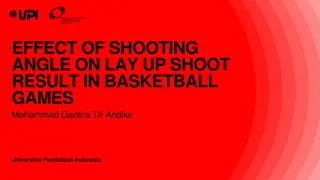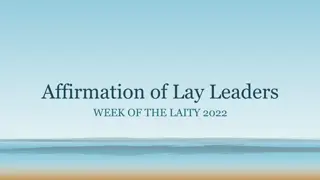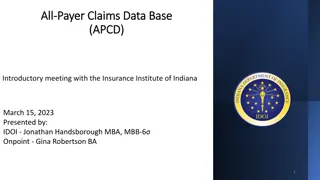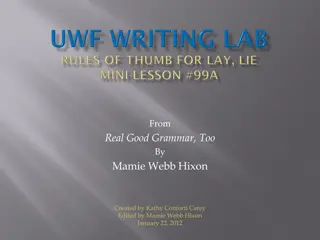Lay Testimony in VA Claims: Understanding Criteria & Laws
Crystal M. Trulove explains the importance of lay testimony in VA claims, covering definitions, laws, and effective strategies. Learn how to utilize lay evidence to enhance your case with real-life examples and practical exercises.
Download Presentation

Please find below an Image/Link to download the presentation.
The content on the website is provided AS IS for your information and personal use only. It may not be sold, licensed, or shared on other websites without obtaining consent from the author.If you encounter any issues during the download, it is possible that the publisher has removed the file from their server.
You are allowed to download the files provided on this website for personal or commercial use, subject to the condition that they are used lawfully. All files are the property of their respective owners.
The content on the website is provided AS IS for your information and personal use only. It may not be sold, licensed, or shared on other websites without obtaining consent from the author.
E N D
Presentation Transcript
Using Lay Testimony to Augment the Claim By Crystal M. Trulove November 18-21, 2019
Introduction Introduction Crystal M. Trulove crystal.trulove@gmail.com Air Force veteran Familiar with military culture Veterans Affairs veteran RVSR for 8 years DRO for 3 years Hearings Appeals Team evidence 2
Lay Testimony, in three parts Part one Lay Evidence & Testimony Definitions Criteria & Uses for Testimony Examples Part two Pain/Functional Loss/Flare Ups Definitions Laws/Court Cases Addressing Pain Examples Part three VA as partner Exercises 3
Course Objectives Define Lay Evidence/Testimony/Statement Define Pain/Functional loss/Flare Up Identify when lay evidence is/is not needed Understand criteria for effective lay testimony Understand laws governing lay testimony Know how VA laws & court cases got us where we are today Be able to coach someone and/or write an effective lay statement 4
References References 38 CFR 3.303 38 CFR 3.304(d) 38 CFR 3.159(a)(2) 38 CFR 3.159(c)(4)(A), (B), (C) 38 CFR 4.40, 4.45, 4.59 M21-1 I.1.C.3.d. M21-1 III.iii.2.E.2.b. M21-1 III.iv.3.D.4.h. M21-1 III.iv.5.A.2.b. & c. M21-1 III.iv.6.C.4.a. Court cases please see handout https://www.knowva.ebenefits.va.gov/ 5
Lay Evidence Basics Lay Evidence Basics Why is it called lay evidence? Lay persons Why is lay evidence used? Fills in blanks Can raise body of evidence to equipoise Why does VA accept lay evidence? Required by law Lay evidence is helpful 6
Legal definition 38 CFR 3.159(a)(2) Competent lay evidence means any evidence not requiring that the proponent have specialized education, training, or experience. Lay evidence is competent if it is provided by a person who has knowledge of facts or circumstances and conveys matters that can be observed and described by a lay person. 7
Service Connection Requires three components: 1. a current disability 2. an event, injury, or disease in service, and 3. a link or nexus Lay evidence must address one of these. Lay evidence is accepted at every claim level, for the life of the claim. 8
Examples of lay evidence Veteran s statement (spoken or written) Lay statement (spouse, friend, family) Buddy statement Photographs Newspaper clippings Performance evaluations Copies of bills paid on time Q: What if veteran s uncle is a nurse who wants to provide testimony? 9
Lay Testimony requires both: Credibility Person making statement is believable e.g. malingering, exaggeration Competency Person s words have value e.g. description of symptoms vs diagnosis M21-1 III.iv.5.A.2.b. accept evidence at face value M21-1 I.1.C.3.d. without contradictory evidence, VA must accept lay statements as true 10
Valuable lay testimony Veteran s description of their own experience Witness to same in-service event (another veteran) Witness of current symptoms (spouse, co-worker, neighbor) Opinion of how disability is related to event in service Comparison before service event and now Spouse also heard what doctor said Description of how bad pain can get Example of how symptoms impact daily life 11
All true but helpful? Neighbor says she watches veteran walk to mailbox with a limp Veteran reports unit, rank, and theater Letter from sister saying veteran has always loved his country Facebook friend knew veteran in high school Buddy was there the day of the fire Spouse says bills are piling up 12
Combat veteran lay statement 38 CFR 3.304(d) Combat. Satisfactory lay or other evidence that an injury or disease was incurred or aggravated in combat will be accepted as sufficient proof of service connection if the evidence is consistent with the circumstances, conditions or hardships of such service even though there is no official record of such incurrence or aggravation. 13
Changing culture Court decisions have reinforced the need for VA to value lay testimony. Buchanan v Nicholson, June 2006 Mclendon v Nicholson, June 2006 Barr v Nicholson, June 2007 Jandreau v Nicholson, July 2007 The law consistently values a veteran s lay testimony. 14
KnowVA Knowledge Base https://www.knowva.ebenefits.va.gov/ Decision Assessment Document VA summary of case Impact on law Impact on procedure Link to full case 15
During/after C&P exam Before exam Research Rating Schedule requirements Mild, moderate, severe Find symptoms that match Submit lay testimony During exam Bring notes After exam Take notes Submit lay testimony 18
Pain Basics Pain Basics What are terms related to pain? Painful motion Functional loss Flare up Why report pain? Minimum compensation for joints Employment impact May be the only accurate report Establishes a more complete picture Can be considered a disability 19
Definitions Painful motion Pain while a joint is in motion Functional Loss Inability to perform normal working movements of the body. Employment impact. Flare-Up Temporary functional limitation 20
Functional Loss 38 CFR 4.40 The functional loss may be due to absence of part, or all, of the necessary bones, joints and muscles, or associated structures, or to deformity, adhesions, defective innervation, or other pathology, or it may be due to pain, supported by adequate pathology and evidenced by the visible behavior of the claimant undertaking the motion 21
The Joints 38 CFR 4.45 As regards the joints the factors of disability reside in reductions of their normal excursion of movements in different planes. Inquiry will be directed to these considerations: (f) Pain on movement, swelling, deformity or atrophy of disuse. 22
Painful Motion 38 CFR 4.59 With any form of arthritis, painful motion is an important factor of disability ...The intent of the schedule is to recognize painful motion with joint or periarticular pathology as productive of disability. It is the intention to recognize actually painful, unstable, or malaligned joints, due to healed injury, as entitled to at least the minimum compensable rating for the joint 23
Lay Testimony of pain Medical terms that may need Lay Testimony Guarding Prostrating Incapacitating Instability Panic attack Headache Tinnitus Plantar Periarticular Voiding How to report pain? Without exaggeration Describe worst day (38 CFR 4.40) Frequency, severity & duration of flare ups Employment impact Daily impact 24
Changing Culture DeLuca v. Brown 1995 Functional loss due to pain includes flare ups and repetitive use Examiners must opine additional loss of function Sanchez-Benitez v. West 1999 Incorrectly determined that pain alone does not constitute disability Jones v. Shinseki 2010 Allows examiners to state speculation Mitchell v. Shinseki 2011 Painful motion is not the same as limited motion Added question to DBQs 25
Changing Culture Joyner v. McDonald 2014 Said Veterans Court erred in concluding that pain cannot constitute a qualifying chronic disability Sharp v. Shulkin 2017 Examiners must demonstrate attempt to discern functional loss due to flare-ups not during exam Ask the veteran Saunders v. Wilkie 2018 Pain, even in the absence of a presently diagnosed condition, can cause functional impairment Officially overruled Sanchez-Benitez v West 26
Evidence of pain in testimony Saunders v. Wilkie Vet must demonstrate that pain reaches the level of a functional impairment Petitti v. McDonald objective evidence of pain is not required, but pain must be objectively confirmed Lay statements must be considered 38 CFR 4.59 provides guidance for painful motion: facial expression wincing, etc., on pressure of manipulation muscle spasms, or crepitation in tendons, ligaments, or joint structures 27
Pain as a disability Saunders v. Wilkie 2018 Pain, even in the absence of a presently diagnosed condition, can cause functional loss/impairment Rare cases PCP and VA examiner unable to provide diagnosis Patellofemoral pain syndrome Costochondritis Pain is related to military service 28
Be A Detective: Why is this valuable testimony? Veteran goes to work every day, despite suffering with migraines Veteran almost fell twice in past month when knee seized up Veteran bus driver has to stand to fully turn lever to close door after passengers are seated Veteran has learned to use computer mouse with left hand to protect right wrist Veteran wears sunglasses, even on cloudy days, to prevent episodes 29
Consider VBA a partner Since 2015, VBA has managed an inventory of 350,000 claims In the past three years, VBA has processed over three million claims 2,778 per day Mandatory overtime has been enforced most years since 2011 30
Consider VHA/VBA as partners In FY2017 veterans made up 32.4% of VA employees Disabled veterans made up 16.6%, or just over half of all veteran employees are disabled vets Other employees include spouses, family, friends of veterans 31
Consider VHA/VBA as partners Keep in mind that VHA/VBA employees: Work hard Keep it short! Are vets Understand the military Want to help Make it easy for them Learn when it is best NOT to send in more evidence 32
Practice Research 7122 Cold injury residuals: With the following in affected parts: Arthralgia or other pain, numbness, or cold sensitivity plus two or more of the following: tissue loss, nail abnormalities, color changes, locally impaired sensation, hyperhidrosis, X-ray abnormalities (osteoporosis, subarticular punched out lesions, or osteoarthritis) Arthralgia or other pain, numbness, or cold sensitivity plus tissue loss, nail abnormalities, color changes, locally impaired sensation, hyperhidrosis, or X-ray abnormalities (osteoporosis, subarticular punched out lesions, or osteoarthritis) 30 20 Arthralgia or other pain, numbness, or cold sensitivity 10 33
Exercise #1 34
Exercises #2 & #3 Write a rough draft lay statement Groups of two One person is veteran, one VSO Veteran has information, but is shy Don t volunteer information VSO must ask questions and write a lay statement for the veteran 5 minutes to read, 10 minutes for interview Switch roles for exercise 3 35
QUESTIONS? Crystal M. Trulove crystal.trulove@gmail.com
